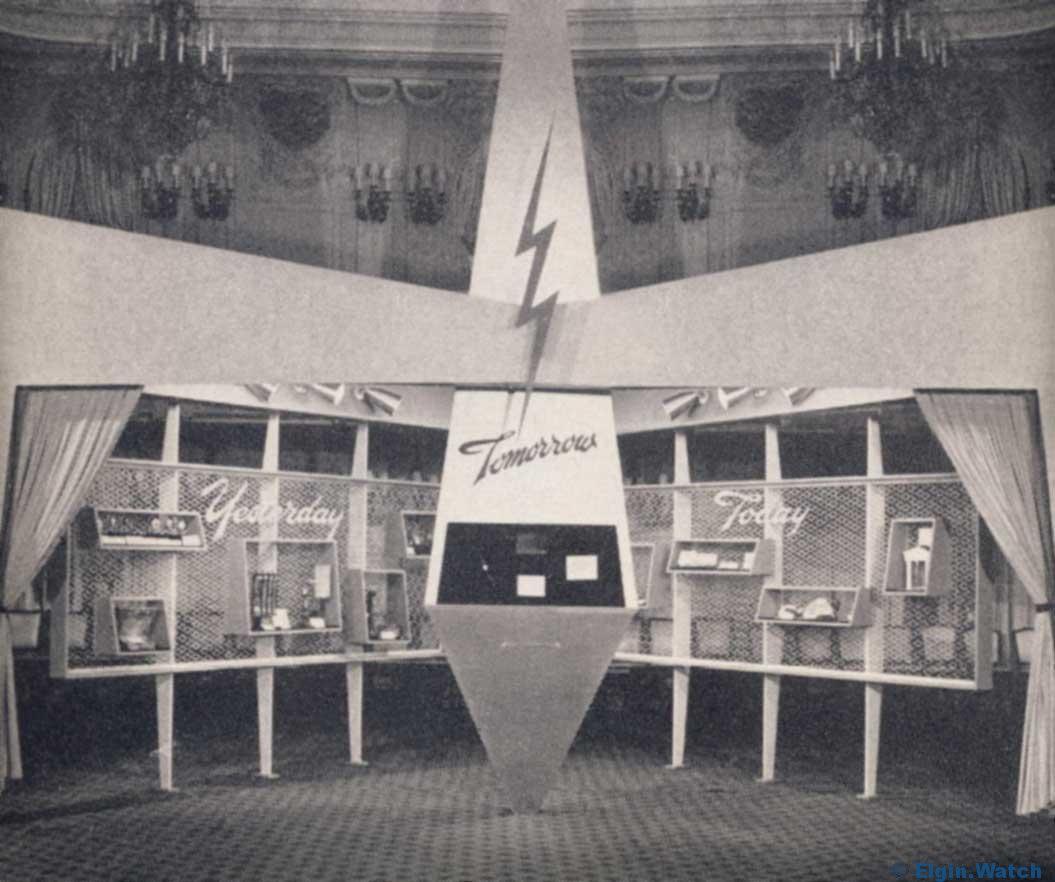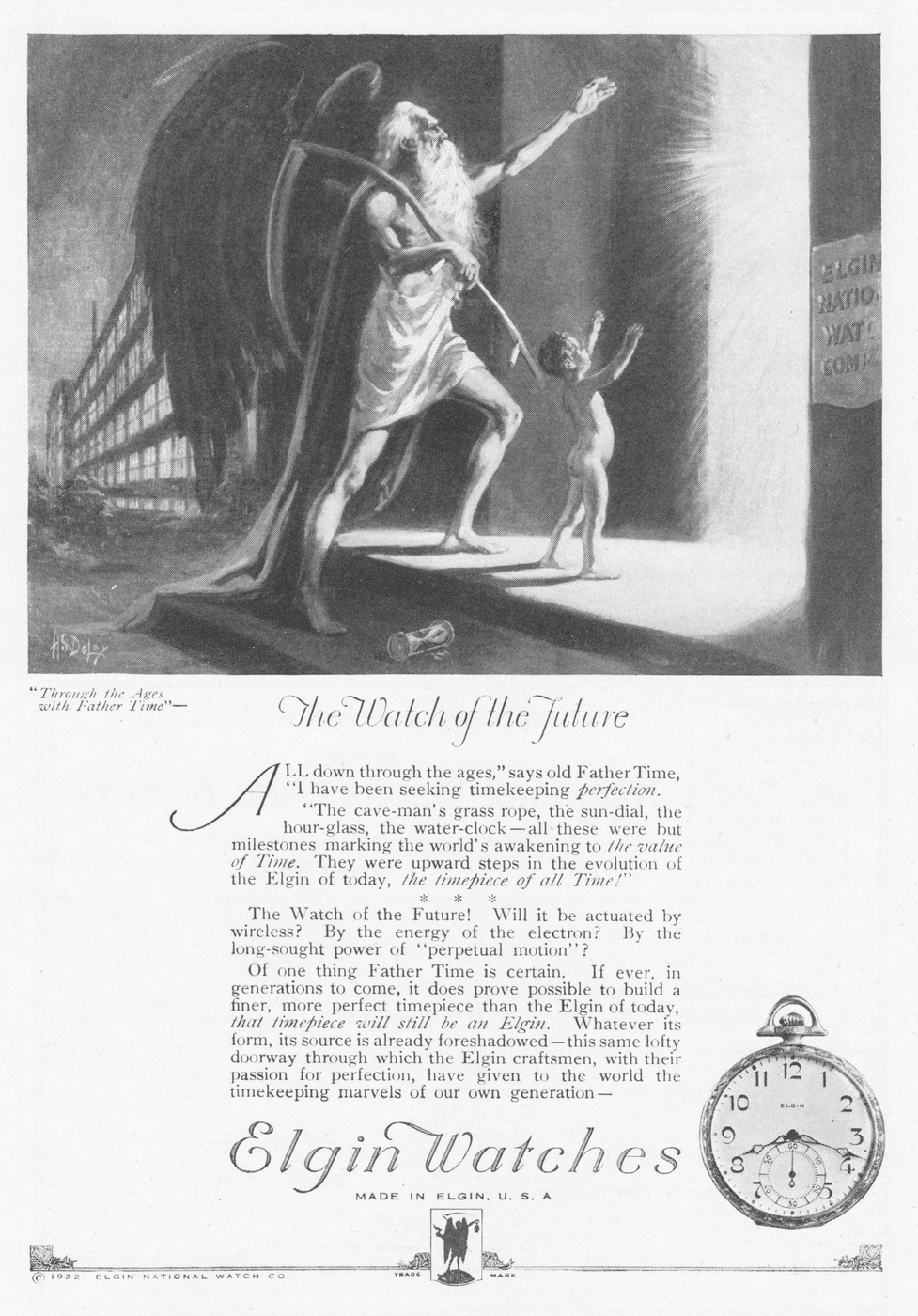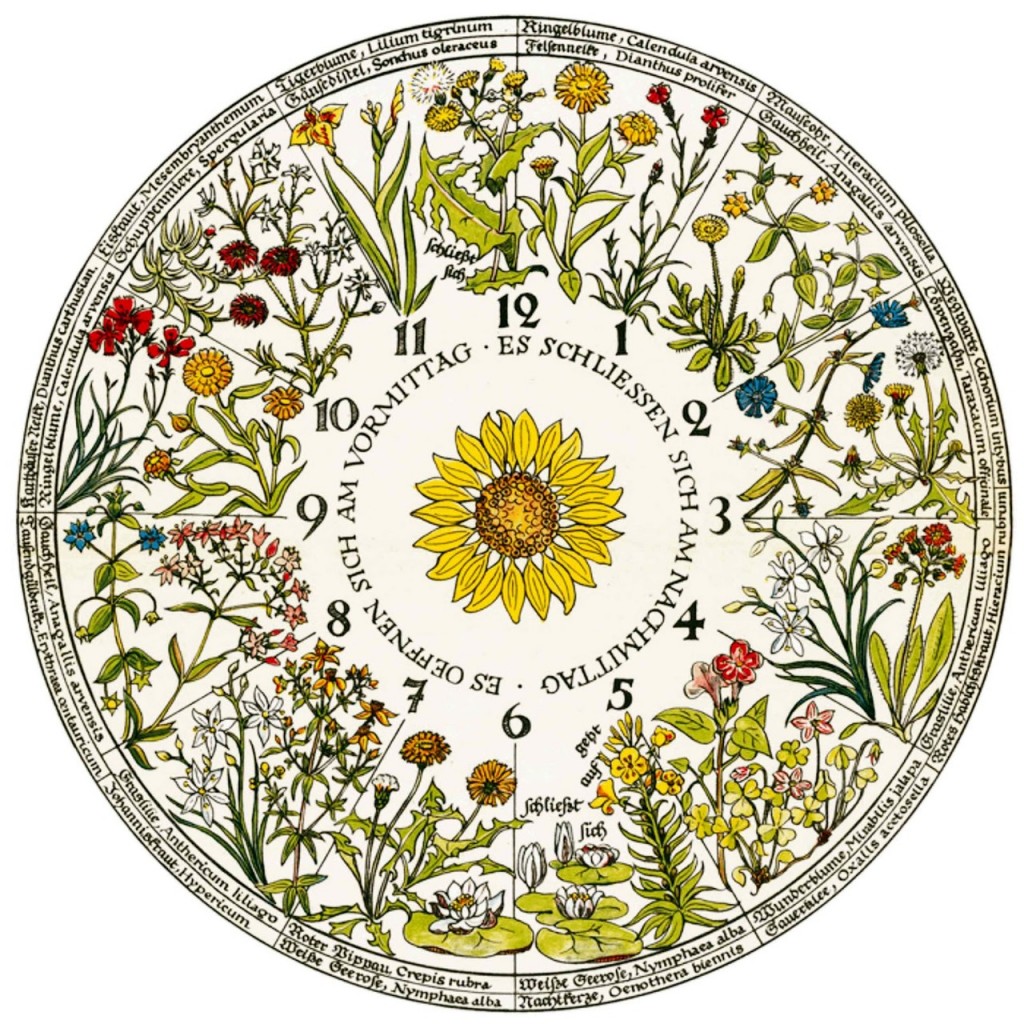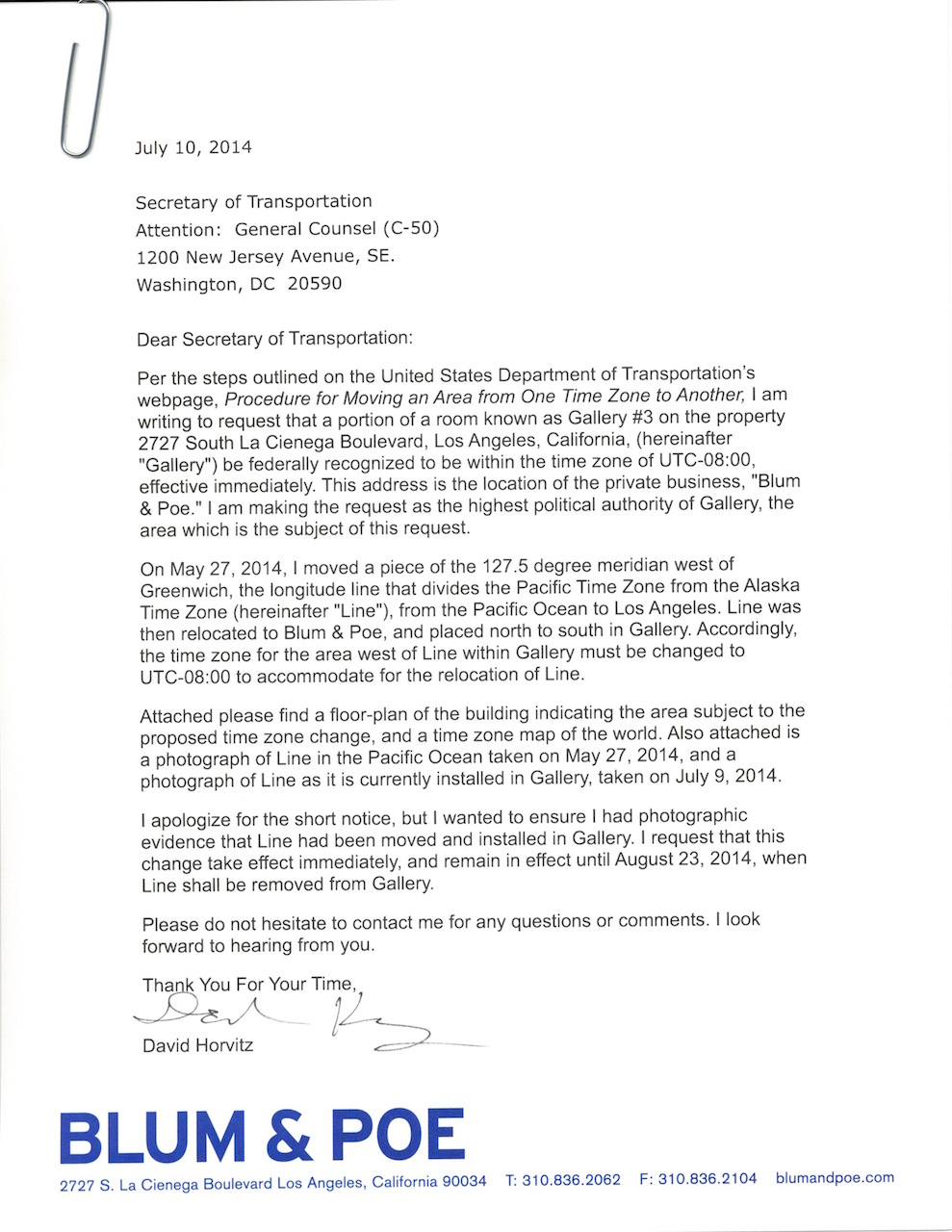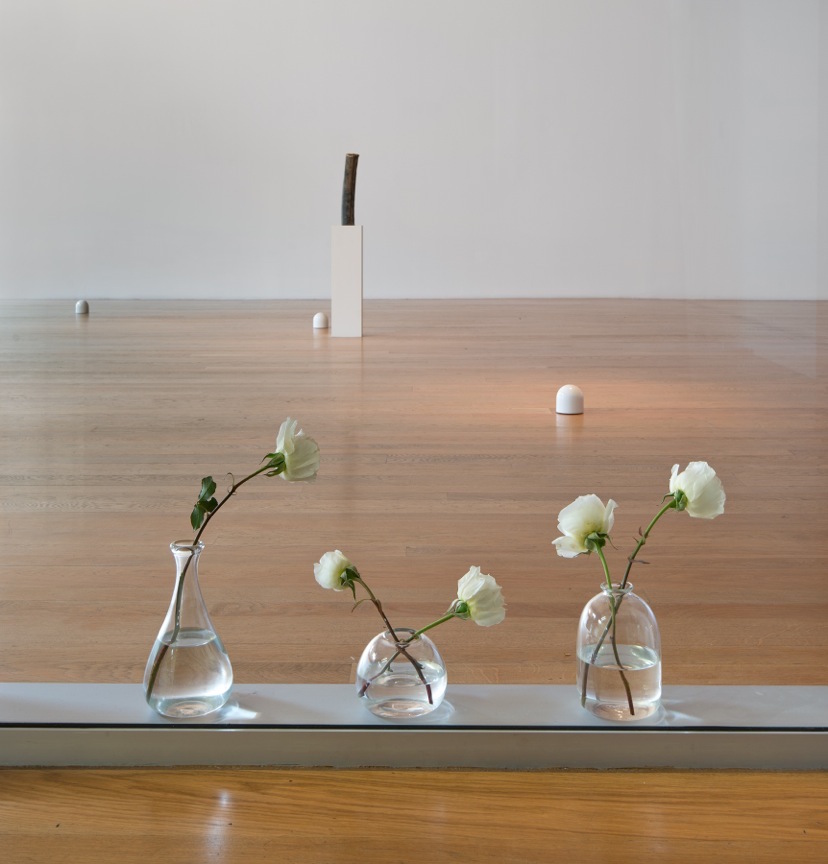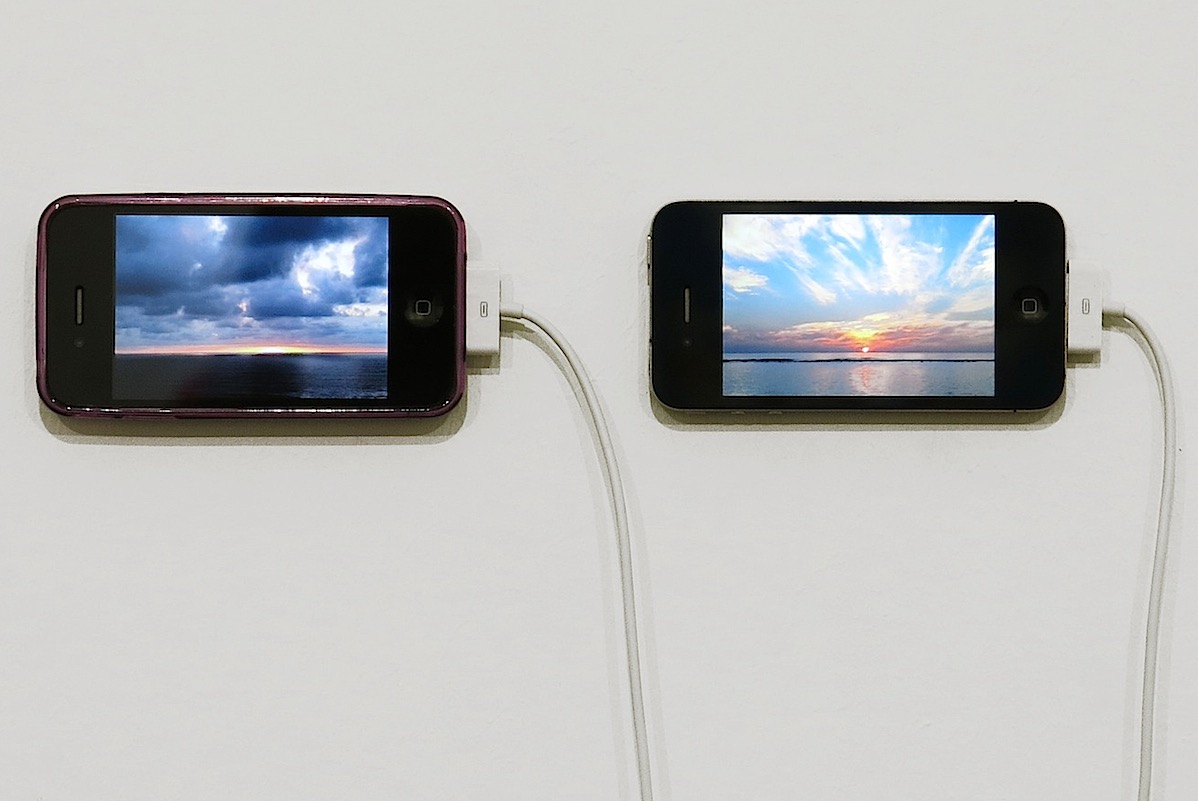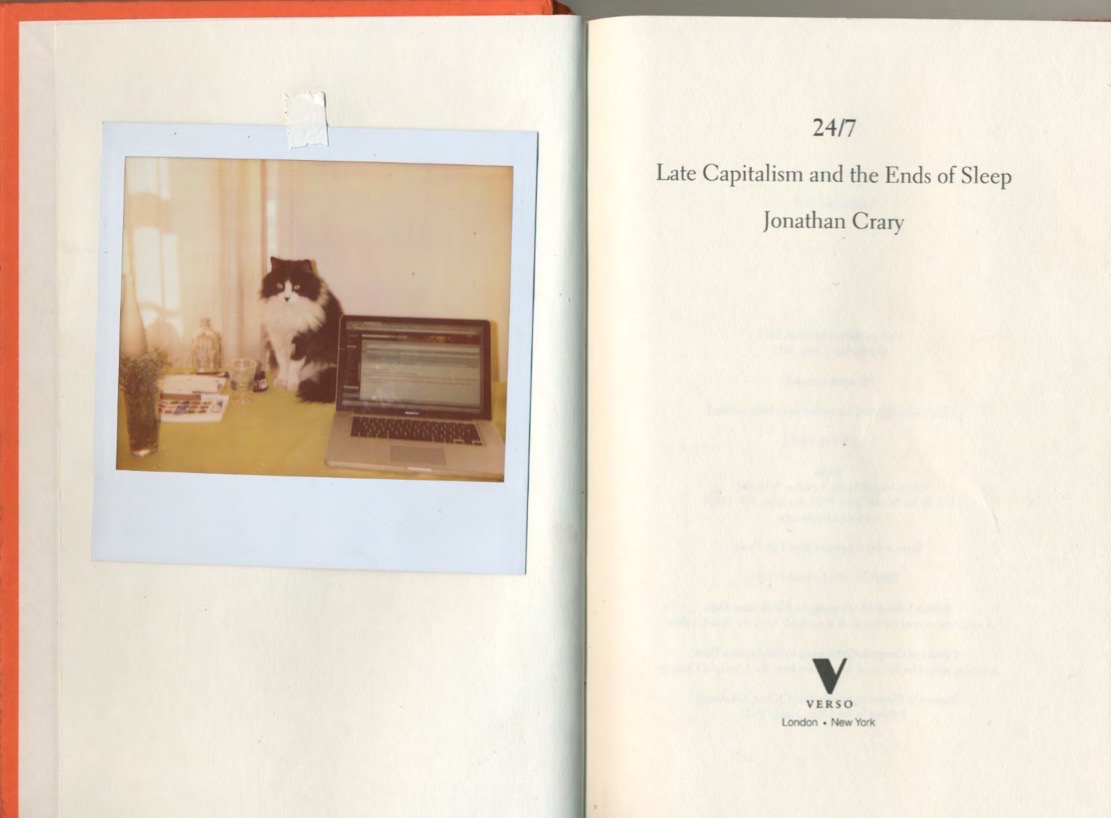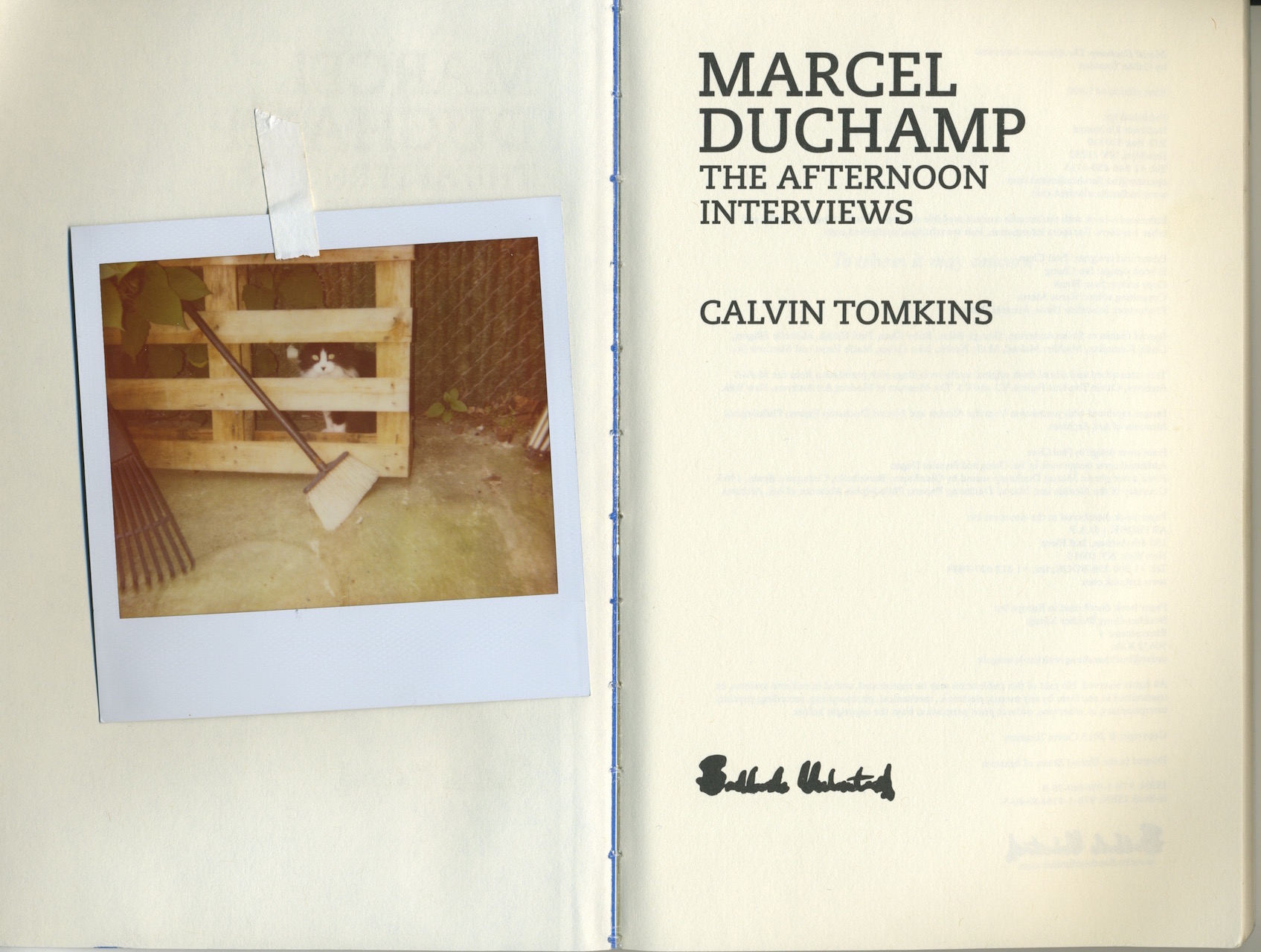What follows is a conversation about the standardization of time, space, communication, and the rhythms of our bodies. The conversation began in earnest in the summer of 2014 and was conducted via email, text message, telephone, postcard, and word processor, as well as in person. The authors cover ancient Egyptian astrology and atomic clocks, the auditory landscapes of nineteenth-century villages and the contemporary landscapes offered by geostationary satellites; they ask how we might recover forms of experience and interaction that now seem antiquated or implausible. They have, in the process of revising and rearranging their words, conflated multiple places and periods: The meaning of “here” may be ambiguous, and “recently” may refer to four years ago or last month (or both). Which is to say that the conversation represents—and, perhaps, furnishes the reader with—a particular experience of time, one that affords simultaneity without eschewing linearity.
Day 1
Alexander Provan On April 9, 2015, you wrote to me, “We can say we’ll meet on ‘Tuesday’ but Tuesday can become Saturday! See u Saturday.” You went on to say that you’d been thinking about the battery life of MacBooks, which may indicate that the computer has one hour of life left, but depending on usage—how many browser tabs you open, how bright you make the screen—the computer may shut down in half an hour or two hours.
David Horvitz This is one of the ways we mark time with technology: There are no fixed units of measurement apparent to us, no fixed durations between each percentage (or even minute). But nevertheless the time is clearly stated.1 You begin to experience time as a countdown, like in ancient Egypt, when the hours were marked by the moments when particular stars happened to rise above the horizon. Astrology is the foundation of the concept of time.
The Egyptian model divided the sun’s route into thirty-six sections, which were marked by stars—also symbols—called decans; the duration between decans varied. Moments in time were defined by whichever celestial event was happening. The title bestowed on Egyptian priests who attended to the zodiac literally translates as “who is in units of time”; it’s typically translated as “astronomer” but might better be understood as “calendarist” or “timekeeper.” To keep time was to watch the sky—which reminds me that Julius Thomas Fraser, in Time, the Familiar Stranger (1987), writes, “What did good Greeks or Romans do when they were inside a templum or observed one of the ‘houses’ in the sky? They viewed, they beheld, they surveyed and reflected. The Romans called that kind of activity con-templatio. (The prefix con- means ‘together,’ ‘with others.’) We now call it contemplation.” To contemplate is to look at the sky.
Provan Fraser quotes the third stanza of Cecil Day-Lewis’s poem “Is It Far to Go?” (c. 1940), which is inscribed on his gravestone:
Shall I be gone long?
For ever and a day.
To whom there belong?
Ask the stone to say,
Ask my song.
To Fraser, the next-to-last line invites us to consider time in relation to the physical world, while the last one reminds us that the ultimate measure of time is, of course, humanity. But is this still the case? Your fixation on time has to do with the fact of the organization of life into standardized units of measurement in order to coordinate and monitor nearly all our activities and expressions, whether since the Industrial Revolution or the advent of geostationary satellites keyed to the monitoring devices in our pockets—which, when you think about it, isn’t so enticing. Who wouldn’t prefer the rhythms of one’s body; the hyper-local and artisanal time of the sun and moon? But certainly it’s much easier to go with the machinic flow than to operate according to one’s own idiosyncratic rhythms. That takes time, right?
Horvitz I want to believe that we can each have our own time—or that we can purposefully fall out of sync with the time of clocks and calendars. In 2014, I did a project in Dublin that involved going about my daily life while on California time for about two weeks. I ate breakfast ten hours after breakfast time in Ireland. I spent most of my waking hours walking around by myself at night. I saw a lot of foxes; I watched a blue heron wade every night in the River Liffey. By the end I started to feel insane. My body was trying to adjust to the local diurnal rhythms, but I was consciously resisting.
With decans and sundials and other traditional forms of timekeeping, our relationship to the cosmos is more or less evident: Time is discerned by the shadow of an object that stands somewhere between the earth and the sun. What are you looking at when you check your phone to see the time and date, except for the artificial order imposed on reality? This order, composed of innumerable interlocking standards, works really well; but it also benefits certain systems of communication and exchange while marginalizing or suppressing many kinds of interaction and experience. Before the creation of time zones, one town would be a few minutes ahead of a neighboring town; a sense of place was tied to a sense of time. What’s lost with the synchronization of nearly every place in the world is the ability to experience any one place apart from any other.
Recently, I was with a friend in the mountains in Pennsylvania. He was high on mushrooms. He said, “Does anyone here know the real time!?!” This was after everyone’s cell phones had died and I had changed all the clocks in the house where we were staying. But we can say that at any time. Do you know what time it really is?2
Day 2
Provan According to Wolfgang Schivelbusch’s The Railway Journey: The Industrialization of Time and Space in the Nineteenth Century (1979), train travel made us define towns not by their distinctive features (and one’s experience of them) but by their proximity to other towns; landscape became geographical space. “Every place in such a space is determined by its position with respect to the whole and ultimately by its relation to the null point of the coordinate system by which this space obtains its order,” he writes. People saw this coming. Britain delayed its acceptance of the Gregorian calendar until 1752, and so correspondence with the rest of Europe required dates listed in the Old Style and the New Style. Because of this tardiness, when the calendar was finally implemented the British had to delete eleven days. The public was dismayed. In a print made at the time by painter William Hogarth, you can see a placard marked with the slogan “Give Us Our Eleven Days” amidst a depraved, drunken, dim crowd on the verge of violent eruption. (Brexit’s true origin: the imposition of European-elite time.)3
More than one hundred years later, as the standardization movement took off and “public time” subordinated the timekeepers and church bells of municipalities—never mind the rising and setting of the sun, all clocks were coordinated with London’s Greenwich Observatory—protests erupted in the United States, with its suspicion of federalism, not to mention internationalism. As railroad tracks were extended and connected, and time zones drawn accordingly, Boston’s Evening Transcript blared, “Let us keep our own noon.” You used this as the title for a performance in which forty-seven people ring forty-seven handheld bells (which you made by melting down a French church bell forged in 1742) at local noon, when the sun is precisely overhead.
Horvitz I found that church bell at an amazing bell shop in Berlin, where I used to buy a small handbell every time I was in town. I imagined the church bell as an expression of centralized power: In medieval times, the bell defined the size of a town, which couldn’t expand beyond the range of audibility.
Provan The hours of meals, prayers, and shops were marked by the ringing of church bells, and this had everything to do with religious authority and superstition. The number and volume of bells afforded to a church was determined by its station in the church hierarchy. Bells were often bankrolled and inscribed by nobles, and regularly rung in their honor. Parishioners believed that bells drove away thunderstorms as well as extinguished evil spirits from the air and beckoned angels to pray with them. In Village Bells: Sound and Meaning in the Nineteenth-century French Countryside (1998), Alain Corbin identifies the ringing of bells with a “deep temporality” that is equally entwined with the natural rhythms of life and the eternal battle with demonic forces.
Horvitz I asked a foundry to melt the bell and use the metal to make small handbells. For the performance, the bells are rung together to mark local noon, and then the ringers walk in their own directions, slowly falling out of sync. The ringers stop when they can no longer hear each other, so the performance has forty-seven different endings.
Provan “Listening to a bell conjures up a space that is by nature slow, prone to conserve what lies within it, and redolent of a world in which walking was the chief mode of locomotion,” Corbin writes. “Such a sound is attuned to the quiet tread of a peasant.” With the French Revolution, the use of bells for religious purposes was banned and many were transformed into cannonballs and coins; the qualitative time of localities was supplanted by the quantitative time of the secular state. Thanks to the pealing of parish bells, villagers knew not just where but who they were. After the bells were silenced, regional identities eroded and the rootless, alienated urban proletariat came into being.
Corbin evokes the “auditory landscape” that was extinguished by industrialization: “the gradual transfer of emotion achieved at the expense of a cyclical notion of time … and to the advantage of remorseless, continuously flowing time.” But he also notes that hardly anyone except for the most zealous revolutionaries wanted to stop ringing bells during thunderstorms. For a while, there was a “double temporal system”: Bells split time between tradition and modernity, between warding off Satan and marking the mechanization of labor.
Horvitz Holding the hand bells makes you think about the centuries when time resonated through this metal. I wonder if, after 1793, locals acquiesced and rang the church bells in accordance with French Revolutionary Time, or decimal time: ten hours per day, one hundred minutes per hour, one hundred seconds per minute.
I’m no fan of decimal time, but I appreciate the desire to establish—as an individual, not as a government—novel ways of structuring experience that follow from your ideals, that buck the dominant social rhythms. A lot of people are into yoga and meditation, but I see those as ways of relaxing your mind and body so that you can continue to work efficiently and productively, at absurdly accelerated rates. I’m interested in forms of meditation that cultivate the enjoyment of time, that oppose efficiency, that make you miss every deadline.4
I’m not alone! I recently came across the Society for the Deceleration of Time; I think you can guess what that’s about. (The group employs a Tuscan proverb: “An olive won’t ripen any quicker, however much you mess around with it.”)5
Day 3
Provan You tend to treat the longitude line and other such standards not as natural facts but as incredible inventions, as linguistic constructs and technological artifices, which may represent some kind of new-world-order monolith but may just as well be shrugged off, overwritten, turned into cartoons—absurd and typically vainglorious efforts to coordinate all human activity in service of seamless economic transactions, interoperability. Standards are aesthetic objects, poetic devices, catalysts of disorder and discombobulation.
In 2014, for a show at a gallery in Los Angeles, you exhibited a row of coffee-mug-size glass vessels positioned on the floor in an exact north-south line. Each vessel contained water from the Pacific Ocean that you collected by sailing to the longitude line that divides the Pacific time zone with the Alaska time zone, 127.5 degrees west of Greenwich, England. You moved this imaginary, arbitrary line, which determines spatial and temporal coordination, four hundred nautical miles away.
This struck me both as a profound, poetic gesture and as an elaborate joke.6 I imagine that you wanted to create an experience not so different from the one that your friend had on mushrooms. But that isn’t really possible in a gallery that people visit for twenty minutes, is it?
Horvitz I imagined the longitude line as being excised from both time zones, placed outside of standardized time. The title of the work is Somewhere in Between the Jurisdiction of Time.7 The hand-blown vessels are small enough to fit into your hand, so you can hold them rather than the line holding you. I don’t know what goes on in peoples’ heads when they’re looking at the work, but I’d like to think that viewers can at least imagine reconfiguring time and space to suit their own desires, or sense that time is tangible, that it can be grasped and shaped.8
Elsewhere in the gallery, I placed a piece called Three Standard Breaths, or The Shapes of Hours, which is a reference to Duchamp’s Three Standard Stoppages (1913–14). Duchamp threw a meter-long string up into the air and retraced the shape—which no longer measured a meter—made when it fell to the ground. I got an hourglass, broke it open, measured the sand, then used the sand as material for three unique hand-blown vases. Each hourglass was made with one hour’s worth of sand.9
Provan I’m writing from an old mill in the Swiss Alps, converted into a house sometime in the early 1900s, overlooking a valley marked every few kilometers by the alabaster bell tower of a church emerging from the pines. An aperture in the shape of a Swiss cross has been crudely carved through the bedroom wall so that one awakens bathed in sunlight shaped like the national logo. Switzerland refuses to join the European Union and insists on autonomy and neutrality, but also hosts all the important international standards agencies. The bells chime once on the half hour and copiously on the hour, until ten or eleven at night—I’ve usually had a few drinks by then and I can’t ever remember to note when they fall silent. Each time, I think: Who cares what time it is here? Is each ring an assertion of Swiss time or a reminder of the forces that connect this remote village to every other settlement in the central European time zone? Clocks are pasted to the facades of government buildings like advertisements—for the development of social bonds through mechanical competence, or vice versa. Does anyone here know the real time?10
Horvitz I’m writing from … Big Sur? You’re sleeping on the bed of a sundial. It’s nice to be woken by the sun—a reminder of the natural rhythms that still surround us. The motto carpe diem comes to mind. Instead of understanding “seize the day” as taking full advantage of the moment, as not wasting one second, you could understand it as an injunction to assert control over these structures that dictate our lives. To take control of what time it is. To take control of which year it is, which day it is, which holidays occur, how many days are in a week, how long the minute is, whether there is such a thing as a minute, what the days will be called, what the hours will be called. Isn’t it strange that the days of the week have names but the hours of the day are just referred to by numbers? I think we should name our hours.11
Provan We do! Or the Catholic Church does, via the Roman Breviary, which defined the time of day by the prayer to be uttered: Matins, Lauds, Prime, Terce, Sext, None, Vespers, Compline. The Liturgy of the Hours, promulgated by Pope Paul VI after the Second Vatican Council, relieved some of the burden on the faithful. But by that point the Church, in its efforts to dictate the experience of time, had been supplanted by the Royal Observatory Greenwich. We may think of the placement of the prime meridian at Greenwich and of all derivative meridians, all derivative standards, as acts of God or arbitrariness, but in fact it’s mostly about power, the struggle between worldviews and empires and so on.
Countries used to determine for themselves from which point to measure longitude, but in order to figure out the time in New York and Vienna and Tokyo at once—which became a matter of concern in nineteenth-century commercial centers—a common meridian had to be established. Greenwich, a riverside suburb of London, was anointed in 1884, despite the objections of other nations with their own cherished invisible lines. Why? This being the height of the British Empire, a preponderance of ships were already navigating in accordance with the Greenwich meridian, which further established the country’s supremacy at sea and in trade.
Horvitz When I visited the Royal Observatory I read about a crazy proposal to the competition, initiated by Parliament in 1714, to devise an instrument for sailors to calculate longitude. It called for using a magic powder and had to do with stabbing a dog with a knife, sending the dog to sea, and then dipping the knife in the magic powder every day at noon in Greenwich. The dog, far away from the knife in Greenwich, would then bark because it felt the pain of the old wound. The bark would mark noon, making it possible for the sailors to calculate their longitude.
Provan The Royal Observatory recently had an exhibition called “Longitude Punk’d,” in which steampunk artists—among them Lady Raygun, Herr Döktor, Major Thaddeus Tinker, and Citizen Griffdawg—presented works that assume the form of submissions to that competition, among them a silk observing suit and garments adorned with functional orreries.
Horvitz Let’s not forget the 1894 “proposal” of Martial Bourdin, a young French anarchist: He tried to blow up the observatory, and maybe the prime meridian itself.12 But he died after the bomb he was carrying exploded as he walked through Greenwich Park.
Provan No one really knew Bourdin’s motives; the anarchists claimed they would never bomb an organization devoted to human progress.13 But perhaps it was already apparent at that point that the Greenwich meridian would act as the foundation on which innumerable other means of regulating our lives were to be established? Time, units of measurement, manufacturing methods, paper sizes, construction materials, street signs, satellite data transmission protocols, pant sizes, screw threads, manhole covers, film exposure ratings, file formats, quality-management processes, etc. How do we hold all this in our minds—much less identify the proper target—given the complexity, even invisibility, of all these protocols and processes? It’s impossible; but perhaps that’s why you employ the most fundamental symbols in your work: bells, glass vessels, sand, seawater.
Day 4
Horvitz The Greeks had two understandings of time. One, chronos, a term we still have today, considers time quantitatively, as sequential. The other, kairos, considers time qualitatively, as opportune moments, as indeterminate. You may feel that something is happening outside of chronological time.14 I recently did an exhibition that took place in two locations, one in Brussels and one in Warsaw. No one knew exactly when the opening would occur, because it was synchronized with the moment my friend gave birth. You couldn’t put the date in your calendar (which made it impossible for the gallery to make a Facebook event), and you couldn’t fit the opening into your hourly schedule. So much of life is about organizing time, planning, scheduling, but the show demanded that you embrace the unexpected and the unplanned; it hinged on other rhythms and times, like the time of the body, transpiring at once.15
Going back to that Schivelbusch quote about train travel: I’d like to experience a world in which the concept of defined durations does not exist, in which there is no such thing as a second or minute or hour.16 Two events occur at once but exist independently of each other, separated by a vast expanse of undefined time, like two far-flung villages before the railroad.
Provan You seem like you’d be right at home in pre-revolutionary France—except your work relies on the gulf between the time kept by iCals and the time kept by church bells. Are you suggesting that we found our own Colonial Williamsburg, or otherwise regress however many hundreds of years, if only in our own bodies, whenever the NIST-F2 atomic clock starts to seem too dictatorial? Or are you after phenomenological anachronism, the assimilation of the sensory experiences of earlier eras into our own daily lives?
Horvitz When you look at the time on your phone, there’s no indication of when the day starts and ends. I want to turn iPhones into astrolabes that track the movement of the sun. I want to temper atomic clocks with decans. For The Distance of a Day (2013) I placed two iPhones next to each other: One shows a video of the sunset, shot by my mother in California; the other shows a video of the sunrise, which I shot in the Maldives. The videos were made at the exact same moment but on different sides of the world, so the day is starting and ending at once.
Day 5
Provan When you told me that Tuesday can become Saturday, we were talking about what you might do for this issue of the magazine: a watch whose minute is defined by the wearer’s heartbeat; a performance based on time-elongation practices; a sand piece (“sandard”!); an edition of twenty-four vases, or possibly tequila and mezcal glasses, each made from the sand of one hourglass. You ended up buying an assortment of hourglasses on eBay and creating a glass harp: a collection of glass vessels that resonate when you rub a wet finger in a circular motion along the lip, the tone of each varying with the amount of water contained. Then you created a score, which consists of a list of moments that exceed the bounds of time—for example, “the elasticity of one hour, one minute,” and “the decomposition of your body”—which was performed by the percussionist Susie Ibarra.
Horvitz We talked at one point about the performance consisting of smashing twenty-four hourglasses on the stage and showering the audience with sand. For me, the most exciting part of this project was the point when I smashed the hourglasses, which made me feel like I was destroying or stopping time.17
Provan I felt like Susie was detuning the audience, opening us up to unsystematizeable experiences of time and their inimitable expressions in sound. The series of glass sculptures that you ended up making for this issue of the magazine, Untitled (Dead Horse Bay) (2016), do something comparable, eventually: The sculptures begin with your experience traversing New York’s Dead Horse Bay, combing the beach for sea glass—remnants of bottles, windows, screens, sconces, or fishing floats that end up submerged in the ocean. You then work from watercolor sketches of the landscape to make hand-blown vessels. But each sculpture changes as the pieces of glass expand and contract, and so it asks the viewer (or purchaser) to constantly evaluate not just the artwork but her own perception—and to decide if or when it’s broken, and whether to acquiesce or have it melted down and remade by a glass blower.
Horvitz These sculptures are part of an ongoing series, and each can be understood as its own ongoing series, with the number of iterations being unlimited and up to the discretion of whomever owns the works, which are inherently unstable. (A minuscule amount of glass is lost each time, so at some point, perhaps after being remade one hundred times, the sculpture must be left to decay.)
A few years ago, before I had made any of these works, I was going up to beaches on Long Island to look for sea glass. (Does all my work involve walking on the beach?) I’d found a website that rates different beaches based on quantity and quality of sea glass. I was clicking on random beaches and I came across a page with a photograph of a man with shaggy black hair and a black jacket standing in the sand, next to a fence made of wooden slats, his back toward the camera, sailboats floating on the ocean in the background. I got an uncanny feeling. I was looking at a photograph of myself! The author of the website had sourced a photograph from Wikipedia to depict Crescent Beach, in Glen Cove. He happened to pick a photograph I'd taken as an extension of Public Access (2010–11), a series of self-portraits at California beaches. The photographs were published on the Wikipedia pages for those beaches—all of which are public property, but many of which are difficult to access, due to local landowners—and were free of copyright, for anyone to use.
Day 6
Provan In 1787, just before train tracks and telegraph lines reconfigured the European landmass, Johann Wolfgang von Goethe traveled through Italy by horse and cart. His account of the trip, Italian Journey (1816), includes this impression of a four-day boat ride from Naples to Palermo: “No-one who has never seen himself surrounded on all sides by nothing but the sea can have a true perception of the world and his own relation to it. The simple, noble line of the marine horizon has given me, as a landscape painter, quite new ideas.” For Goethe, this unmediated communion with the natural world was a “decisive event” precisely because it conjured some fundamental correspondence between his body and the terrain; he immediately understood that rare sensation as enriching his capacity for description, as a tool to be applied in the representation of such a moment.
What would you see today when looking at that horizon, at the natural division of the world into two infinite planes? Would you sense that the horizon has changed, that we’re always “surrounded on all sides”—more surrounded, and on more sides, than Goethe would have found conceivable?
Horvitz A friend of mine, Matthew Vollgraff, told me about Friedensreich Regentag Dunkelbunt Hundertwasser, an Austrian artist and architect who was a fierce opponent of the straight line, which he thought was inorganic, “godless,” oppressively rational, stifling to human expression.18 (His name, which he gave to himself, means Peace-Realm Rainy Day Dark-Colored Hundred Waters.) I don’t know if I’m against the straight line, but I am against the deadline.
My cat just came up to me.19 He’s bored because I’m on the computer, this artificial glow fixating my eyes and illuminating my face. I once read that ninjas in Japan knew how to tell the time of day by looking into the eyes of a cat.
Rest
Horvitz Glass works just shipped out. Can’t wait for them to break again!
Provan You can finally stop making new work. Just remake this over and over again.
Horvitz Maybe next time I’ll mail them a glassblower.
Provan You should strongly suggest that the glassblower be hand-delivered.
Horvitz Are you putting this into the conversation?
Provan Yeah, that explains my delayed response.
Horvitz Don’t edit out all the meat.
Provan Did you enjoy the volcano?
Horvitz Which one? Stromboli?
Provan I’ll take the calzone, actually.
Horvitz Three weeks of paradise. Swim at 7 with jellyfish and octopus. Then cappuccino. Breakfast. Nap. Lunch. Cappuccino. Gelato. Nap. Second swim of day. Then dinner. Put my mattress on roof to sleep with stars. Sending you turtle pic.
Provan That’s a sexy turtle.
Horvitz Turtle was hit by boat. Died next day. We read The Gift and gave each other presents.
Provan So sad. About reading The Gift.
Horvitz In German gift means poison.
Provan There are no free poisons.
Horvitz I want to do a poisonous mushroom fancy dinner. $200-ticket fund-raiser. For the hospital bill.
Provan How poisonous?
Horvitz Nothing deadly. We’ll need waivers. 24 hours of vomiting.
Provan People love epic vomiting, so long as you tell them you’re a shaman.
Horvitz We could sell the vomit as an edition.
Provan Each crafted from a single spew.
Horvitz Locally sourced single-origin spew.
Provan We could probably sell it. Although we’d need a really nice box.
Horvitz Archival airplane barf bag, silkscreened.
Provan These are ideas. The amount of vomit would be … the amount spewed in one second?
Horvitz Whose second? Viewer or poisoned?
Provan Good question. I'll look into this now.
Horvitz Which now?
Provan Good question.
Horvitz This cat's eye sundial is AMAZING. IT’S REAL!!! We'll have to incorporate this into the conversation. The end! The last sentence!
1 Returning to the idea of an analog clock that has a different minute. I would make a clock that just has a minute hand, and it would be a different minute. Maybe a series. So you can sit and meditate with them, get attuned to the new minute. Or an offshoot of this: I had the idea once to make a clock whose minute was determined either by someone's breath or heartbeat. This could be how these unsynchronized minutes are defined … or it could be a kind of participatory piece where someone sits with the clock and makes their minute … (or do this digitally???).
2 I didn’t know your father died. We could talk about death. Maybe on mushrooms. Some mushrooms come alive when things die—decomposing organic matter. Maybe I told you this, but a decomposing tree will have different mushrooms show up at different stages in the decomposition. It’s like a clock. You know Carl Linnaeus’s flower clock? Linnaeus tried to make a clock by growing a garden with flowers in a specific order, flowers that bloomed at certain times of the day … so when one flower opened, you’d know that it was 5:00. Amazing. I could make a mushroom clock instead, to tell the time of decomposition and death. I recently was on the eHow page for “How to talk to the dead.” I may try to do it later. I have a complicated dilemma. I want to believe in ghosts. I have many friends who have had encounters. I’ve never had one. I don’t know how ghosts emerge in the evolution of life??? Haha. Do single-cell life forms have ghosts? Or did ghosts come later in evolution, like with consciousness? Or maybe ghosts are just consciousness without a body, existing in a kind of electric field. I don’t even know what I mean by “electric field.” Haha.
3 Boris Johnson on May 9, 2016: “It was an exercise in what I believe used to be called behavioral therapy: inducing a change in the underlying attitudes by forcing a change in behavior. Their inspired idea was to weave a cat’s cradle of supranational legislation that would not only bind the former combatants together, but create a new sensation of Europeanness. … I do not see many signs that this program is working. The European elites have indeed created an ever denser federal system of government, but at a pace that far exceeds the emotional and psychological readiness of the peoples of Europe. The reasons are obvious.”
4 Very quick reply. I have to go to the gallery in Portland (after a fancy espresso). We’re doing a Yoga Nidra class on the floor of the gallery for my show. Yoga Nidra = sleep-dream yoga. Everyone lies on the floor and the teacher guides you into a kind of lucid-dream state. So I am writing fast.
5 This could be a whole subject in itself, deceleration, etc. It could even relate the overworked mind/body, which can’t keep up the speeds and demands of society and falls into depression, which relates to my Mood Disorder piece … but that would be expanding this a little too much!
6 In your recent email you said that you were writing quickly in order to get to your lucid-dream-yoga session. That reverses the equation: You’re trying to be efficient with work in order to sleep-dream on time!
7 Somewhere in between the jurisdiction of time Author: David Horvitz; Alexander Provan; Blum & Poe. Publisher: Art in America, 2014. Edition/Format: Print book: English. Database: WorldCat. Summary: Recently, for an exhibition in Los Angeles at Blum & Poe, I exhibited a row of glass vessels positioned on the floor of the gallery in an exact north-south line. Each vessel contained water from the Pacific Ocean that I collected by sailing to the longitude line that divides the Pacific time zone and the Alaska time zone, 127.5 degrees west of Greenwich, England. I wanted to materialize this imaginary line that…. Subjects: Time in art -- Exhibitions. Time -- History. Prime Meridian. Artists’ books. Time. Time in art.
8 Glass is made from sand, which was once a symbol for passing time, for duration, because it was used in hourglasses. Glass is “an inorganic material obtained by fusion of raw materials—mainly sand, limestone and soda ash—which is homogeneous and isotropic,” according to the International Organization for Standardization. “The fused mass has been cooled down at a rapid and controlled rate, essentially without crystallization in the case of transparent colourless or coloured glass, but with crystallization or phase separation in the case of opaque or translucent glass. The physical and chemical properties of glass are entirely different from those of the constituent materials.”
9 The one thing I’ve thought a lot about regarding this piece is: I love the idea. I’ve always imagined how I could remake Duchamp’s piece with a standard minute or a standard hour: throw time into the air and see what shape is formed. But the vases look kind of lame. Haha. They need the roses. Empty, they are empty.
10 “These people cannot be, from the point of view of power, strangers anywhere in the world; they have made the modern world, in effect, even if they do not know it,” writes James Baldwin in “Stranger in the Village” (1953), an account of his time in the Swiss mountain village of Leukerbad, where he was the only black person. “The most illiterate among them is related, in a way I am not, to Dante, Shakespeare, Michelangelo, Aeschylus, Da Vinci, Rembrandt, and Racine; the cathedral at Chartres says something to them which it cannot say to me, as indeed would New York’s Empire State Building, should anyone here ever see it. Out of their hymns and dances come Beethoven and Bach. Go back a few centuries and they are in their full glory—but I am in Africa, watching the conquerors arrive.”
11 Another thought is hosting a debate/vote where we name the hours. Days of the week have names. Months have times. But hours do not. We could name the hours. Meet me at the thirty-third minute of Babalowow. I don’t know what to name the hours. Let’s vote. What would we do next? I don’t know. Just state that the hours have officially been renamed?
12 I think we should make a prime rib. And serve it on the prime meridian. Half of it is west of the prime meridian and the other half is east of it. Prime meribian. This is the dumbest thing I’ve ever written.
13 Joseph Conrad putatively based The Secret Agent (1907) on this incident. He described the bombing as “a blood-stained inanity of so fatuous a kind that it was impossible to fathom its origin by any reasonable or even unreasonable process of thought. One remained faced by the fact of a man blown to bits for nothing even most remotely resembling an idea, anarchistic or other. As to the outer wall of the Observatory it did not show as much as the faintest crack.”
14 You can even evoke The Shape of Time. But I shouldn’t bring up things I haven’t read! Who wrote that? Some philosopher Robert Smithson was into, I think … it’s in an open tab somewhere. Anyway, I like this reshaping of time, this subjective dimension of time. The shift from time as quantitative (standard measurements) to qualitative (your own shape of time, etc.).
15 You know, time is just a measure of the earth spinning … you could potentially mark how much earth has spun in space for a duration … I’ve always wondered what, in spatial terms, is a second or hour or minute. An hour would obviously be roughly one twenty-fourth of the earth’s surface. This differs at different latitudes because the earth is spinning at an angle … imagine the North Pole … I imagine marking out a second of time on Earth … I don’t know what/how.
16 Did you know that Henry David Thoreau built his own brand of wind harp, or Aeolian harp (Aeolious being the god of wind), which was inspired by the sounds of telegraph wires—which followed train tracks—rustling and clanging against one another in the breeze? He called his instrument the telegraph harp.
17 Don’t tell anyone, but right now I’m listening to a recording made from glass bowls called Crystal Spirit. I found it at the Corning Glass Museum in Corning, New York. Have you ever been? You should go. Glass is ancient and contemporary. It’s a medium for light: windows, glass negatives for photographs, fiber optic cables. It’s essential to contemporary visuality: lenses, microscopes, telescopes, cameras, and the transmission of images through wires.
18 Matthew and I tried to compile a calendar made up of lost holidays, which we published as a spiral-bound publication and PDF called Today Was a Holiday Once Sometime on Leap Day in 2012.
19 My cat collects royalties for his likeness. He also only speaks Korean, so we have to go through his translator. I have to go to the gym and finish listening to the audiobook of Terence McKenna’s Food of the Gods: The Search for the Original Tree of Knowledge. This chapter is on magic mushrooms, opium, cocaine, and … television. I can’t wait. (Checked out for free from LA public library digital audiobook collection!)
